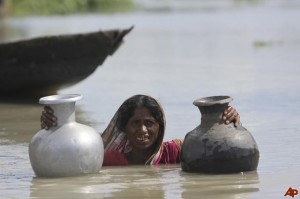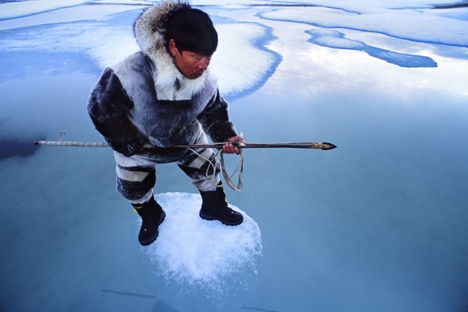When I think about what is likely to result from the global climate change talks taking place in Copenhagen this month, I feel nothing but despair. Why? Because whatever kind of deal is struck is highly unlikely to keep global warming below two degrees. The majority of people in rich countries simply don’t care enough about the issue to pressure their governments into extraordinary action. I believe one of the major reasons for this is the lack of empathy for those who will – or who currently – suffer from the impacts of climate change.

We should view the problem of tackling climate change not as an environmental issue, or one concerning technology or social justice or markets, but primarily as a problem of empathy. We must learn to see the individuals behind the newspaper headlines about global warming, and imagine ourselves into the uniqueness of their lives, developing an empathetic understanding of their most important experiences, beliefs, fears and hopes. Sound far-fetched, wishy-washy or a little too sandals-and-carrot-juice for your liking? Let me explain myself.
The big question facing us is this: how can we close the gap between knowledge and action on climate change? Millions of people in rich countries know about the damaging effects of climate change and their own greenhouse gas (GHG) emissions, yet relatively few are willing to make substantive changes to how they live. They might change a few light bulbs but they do not cut back on flying abroad for their holidays nor do they want to pay higher taxes to confront global warming. So far economic, moral or other arguments have not been enough to spur sufficient action. Could empathy help?
The difficulty is that individuals, governments and companies are currently displaying an extraordinary lack of empathy on the issue of climate change, in two different ways. First, we are ignoring the plight of those whose livelihoods are being destroyed today by the consequences of our high emission levels, particularly distant strangers in developing countries who are affected by floods, droughts and other extreme weather events, such as flood refugees in the Indian state of Orissa. How many of us have made an effort to put ourselves in the shoes of Annapurna Beheri, a woman from Orissa whose home and family shop selling biscuits and tobacco were washed away in 2007, and to imagine how her life has been affected by the realities of climate change? So, there is an absence of empathy across space.
Second, we are failing to take the perspective of future generations who will have to live with the detrimental effects of our continuing addiction to lifestyles that result in emissions beyond sustainable levels. Thus there is a lack of empathy through time. We would hardly treat our own family members with such callous disregard and continue acting in ways that we knew were harming them.
Generating empathy both across space and through time is one of the most powerful ways we have of closing the gap between knowledge and action, and for tackling the climate crisis. The problem is that, until now, empathy has been largely ignored by policymakers, non-governmental organisations and activists.
It is time to recognise that empathy is not only an ethical guide to how we should lead our lives and treat other people, but is also an essential strategic guide to how we can bring about the social action required to confront global warming.
I would like empathy to become the watchword of a new era of policies, social movements, cultural projects and individual action on climate change. How can we encourage this empathetic revolution of human relationships? What exactly might it look like? Here are a few of my ideas for cultivating empathy across space and through time:
Climate Comrades
The old-fashioned idea of pen pals could be revived for the age of climate change. People living in rich countries could engage in one-to-one conversations with those living in poor countries suffering from the effects of global warming, using cheap technologies such as Skype, Facebook, email and webcams. This might be organised through existing or newly forged links between schools, church groups or twin town programmes, with some coordinating help from development agencies like Oxfam or ActionAid. So a teenager in Edinburgh could have regular video conversations with another teenager in Uganda, whose rural community is being hit by drought. Your Climate Comrade would hopefully become a friend for life, opening you up to a new empathetic understanding of what climate change means for people’s livelihoods, and encouraging you to take political action.

Climate Corps
The Peace Corps established as a federal agency in the US in the early 1960s has given hundreds of thousands of young people the opportunity to experience the realities of living in poverty in a developing country, especially in Latin America. I would like to see the European Union establish a similar programme called the Climate Corps. Young people would go on placements for a year to live with a community in a poor country hit by climate change. They would work on adaptation projects such as helping build flood defences and engage in other work of use to their hosts, such as teaching English to village children. In EU countries with military service, Climate Corps should be offered as an alternative option. With the right marketing, joining the Climate Corps could become a rite of passage for young people as popular as back-packing for a year before university. One of the rules of Climate Corps is that you must travel to and from your destination without exceeding a carbon emission limit, which would force you to avoid travel by plane. Climate Corps would be a major boost to generating empathy across space.
The Climate Futures Museum
Without a time machine, it is impossible to give people direct experience of the future. But we can find ways to simulate the projected realities of everyday life a century from today. That is why every major city in the world should establish a Climate Futures Museum. The purpose of a Climate Futures Museum would be to provide experiential learning designed to develop our empathy with future generations who will have to live with the impacts of climate change if we fail to take concerted action in the present. The museum would not contain standard informational displays behind glass cases or on computer screens. Instead, it would house experiential exhibitions that allow visitors to understand in reality what it would be like to have their homes flooded, to be faced by drought, or to experience a hurricane. You might have to put on a life jacket and be tossed around in a dinghy in a wave machine. Creative minds would be needed to design an empathetic experience that would be etched in your memory for ever. (In fact, I’ve already begun working on this project with the ecological artist Clare Patey and the sustainable designer Sophie Thomas.)
While I certainly believe that global political agreements like that being negotiated in Copenhagen are vital for tackling the uniquely cross-border issue of climate change, there is no doubt that raising empathetic awareness at the grass roots is equally necessary. This is not simply because there is still so much denial and scepticism about the realities of man-made climate change. It is also because empathy has the power to create the human bonds required to catapult us into social action.
Earlier today I was at a climate change demonstration in central London together with around 40,000 other people. An elderly woman next to me had a photograph of a tiny baby hanging around her neck, contained in a plastic sleeve. Underneath it said, ‘I’m here for Alice, aged one month’. That photograph, for me, was a small sign of hope that, deep within us, we all understand the importance of empathy.
This is an revised version of an article that first appeared on George Marshall’s brilliant Climate Denial blog. It is based on a research paper I wrote for the Future Ethics project at the University of Manchester called Empathy and Climate Change: Proposals for a Revolution of Human Relationships
To hear me talking about empathy and climate change, here is a six-minute video.
Great stuff Roman.
This is somewhat unrelated to the climate change post, but I wonder whether you saw Gerry Robinson’s brilliant expose of dementia homes in the week? In it, he explored the varying approaches to caring for our elderly, in particular those with dementia.
Care home owners are all subject to the same set of targets and measures, many of which are related to health and safety. Yet there was a visible difference between care homes. In the very best facilities, residents were engaged, active, willing. In the worst, residents were treated serviced as ‘cases’. Why this difference?
The only difference I could discern was that some care home owners had the capacity, or the willingness, to step into the shoes of their residents. One in particular provided vastly superior services at the same cost of those whose services were little better than a waiting room for death. And the difference had nothing to do with money or targets or service level agreements. The difference was empathy.
Good luck with this blog.
Rob – http://www.bloompsychology.com